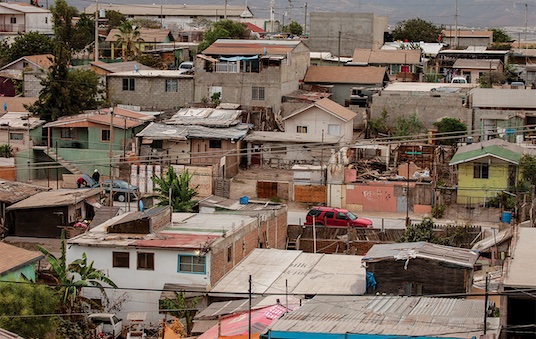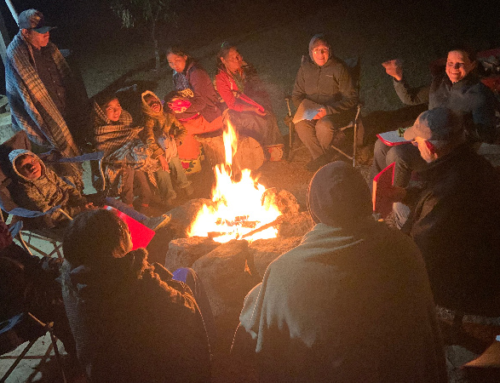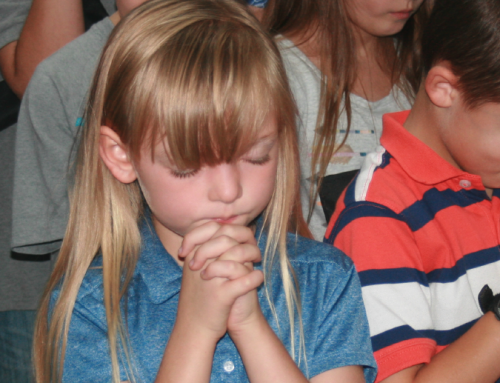What picture comes to mind when you hear the word missions? For many, the picture would involve Western missionaries residing among a remote, unreached people group. The missionaries learn the language, present the gospel and establish churches.
Pioneering missions has always been among the most challenging types of mission work. And in the more than 75 years of our existence, Ethnos Canada and our network of global partners have gained monumental insights into effective discipleship among unreached people groups.
Larry Brown, CEO of Ethnos360 explains: “I think when we first started as an organization, … it was difficult, but in some ways, it was pretty definable. You go into a people group. That people group was pretty isolated. … It was easy to identify the one language, the culture. You see how they relate to other language groups or cultures. But you were working with a pretty set known culture and language.”
That picture would be very accurate.
At least, it used to be.
Five Factors
“A tangled ball of yarn.”
That’s how Larry Goring, Director of the International Ministries Team serving Ethnos and its global partners, pictures the complexities of missions today.
From the time of Ethnos’ inception in 1942 until today, the world has changed drastically, impacting unreached peoples. Larry Brown pointed out, “The world is very small today, and no country is insulated from things that are happening globally.”
Once a people group has been identified as being truly unreached, as discussed in “Who Are the Unreached of the World?” in the previous issue, Ethnos and our global partners consider how best to reach them.
A thorough consideration of various factors which impact an unreached people group gives us a place to start to untangle that ball of yarn. As each strand is explored, we gain a clearer understanding of how we might best engage with those people.
We consider five specific factors regarding an unreached people. Those factors are physical environment, culture, readiness to listen, access and positioning.
And each of these factors is examined along a spectrum of least impact to most impact.
All of that may sound a bit theoretical. So, let’s explore the first strand — the physical environment.
As we consider the various complexities of missions today, we’ll discuss how some of these factors affect the work to reach the Triqui people.
In 2015, the Triqui people of Mexico were featured in Ethnos magazine (ethnos.ca/the-joy-of-yes).
Physical Environment
Of the five factors, physical environment may be the most tangible and least difficult to discern.
Larry Goring explained that a people group’s physical context can vary from traditional homeland settings, like the mountain top villages of Papua New Guinea with the iconic round houses to the slums of the world’s megacities. Cell phones and internet seem to be everywhere.
Some groups of unreached peoples live much the same way their families did two or three generations ago, but they are in the minority. Marked by isolation and lack of change, they are often the picture that springs to mind at the mention of “missions.”
Other groups remain less isolated and adjust to outside influences, moving them toward integration with the larger national culture.
“The world is very small today, and no country is insulated from things that are happening globally.”
Still other groups have experienced severe or rapid change regarding their physical environment. This could be a result of such things as deforestation or changes in property ownership. Many leave and seek employment elsewhere, resulting in demographic changes.
Further along the spectrum would be groups that have been relocated or displaced from their traditional homelands. The people may relocate because of urbanization, unproductive lands or pollution.
At the end of the physical environment spectrum would be groups that are displaced because of war, disaster or other catastrophes. These people may live in urban slum groups or refugee camps.
The Triqui are a displaced people group. Traditionally from the southern Mexican state of Oaxaca, many Triqui people have migrated to the state of Baja California in Mexico in order to escape violence that has overtaken their homeland.
“The context is challenging,” said Peter Hypki, field chairman of Misión Pro‑Indígena, one of Ethnos Canada’s global partners. “Baja California was described during an International Ministries Team visit years back as one of the most complex missions environments in the world. There are multiple displaced people groups.” Though there is much mission work being done in the area, little is done in the heart language of the Triqui people.
Physical environment is just one factor that we seek to understand about an unreached people group. Let’s examine the next factor — culture.
Culture
Culture is a little word that represents a lot. It is essentially the totality of shared beliefs, attitudes and values of a people. Language is a verbal representation of a people’s culture. And worldview is the way that a people understand the world around them.
When our teams examine how a people’s culture, language and worldview have responded and adapted to change, we’re examining an area of major significance.
Let’s consider the spectrum of cultural responses to change, again from least impact to most impact.
Some groups resist outside influences, groups that are stalwart in their holding of their culture. But these groups are the minority.
Others selectively respond to globalization, such as by adopting areas of technology, education and bilingualism. But the heart of the culture remains strong.
Rapid cultural change is next on the spectrum. People begin to abandon their cultural norms.
In more extreme cases of rapid change, the culture does not have adequate time to adjust. Instead, it collapses, and there is little sense of cultural cohesion.
At the furthest end of this spectrum of cultural change is human collapse. Substance abuse, human trafficking, civil unrest, war and even loss of the will to live is not uncommon.
Willingness to Listen
The next factor is a group’s willingness to listen to the gospel message.
Some are eager to listen. As examples, animists may be excited to learn of another spirit that might benefit them, while polytheists may be eager to add to their assemblage of spirits. Though people may be willing to listen, that doesn’t necessarily mean that the spiritual soil has been prepared.
Other potential listeners may be indifferent or are distracted by materialism.
In many cases there is resistance or even complete opposition to the gospel. This often occurs in the context of major world religions.
Larry Goring explained, “Each of the major religions seem to be building a cultural crust of sorts around their followers,” keeping them at a distance from the truths of Scripture. Major religions have roots in all aspects of a people’s way of life.



Many Triquis living in Baja California, Mexico, still speak their indigenous language and wear traditional clothing. But some of the younger generation of Triquis have never seen their cultural homeland.
At the end of the spectrum is the increasing
trend toward open opposition to the gospel and
persecution of believers.
“Without a doubt, the work and efforts of local and foreign ministries to reach indigenous people have affected syncretism,” Eduardo Meléndez, missionary to the Triqui people, said. “Indigenous people come from a background, where before, by [attending church, giving, praying] and being in an environment ‘where God is,’ it makes them feel that they are in good standing with God.”
Tom Carlton, with Misión Pro-Indígena, added that “it can be hard for people to be interested and open to the teaching. They already believe that they understand what Christianity is about.”
Also, the urban context provides “alternatives for entertainment … such as: markets, parks, beaches, bars, internet, phones, satellite TV and more,” Eduardo said. “These can be a distraction for many unbelieving Triquis, who are not hungry for God, being very easily caught up with the new [things available.]”

Access
“Access” is the ability for someone with the gospel to share it with a people.
“Who can have access?” and “What people group?” are the key questions.
Access to much of the unreached world is restricted or even closed to Canadian missionaries. However, Ethnos, as part of a multinational team, can participate in many ways in the global effort of our partners around the world.
Looking at the spectrum of access, in a handful of places unreached groups invite missionaries to come live with them and teach. Their governments have very little restriction placed on missionaries’ activity. But this is increasingly rare.
Instead, there is usually some level of restriction. Larry Goring noted, “Most countries that are home to unreached peoples require mountains of paperwork, permits, fees and special requirements.”
Further restricted locations only grant limited access due to religious opposition or growing restrictions on Westerners.
“… if we want to do what we say we do, as far as reaching the unreached, we [had] better embrace the messiness of it.”
On the far end of the spectrum are locations that do not allow access. The country could be closed to outsiders. Or the country might be open, but access to indigenous peoples is restricted.
“With the right relationships of trust, a Mexican has no problem being heard by the Triqui or another group,” said Eduardo. They will listen to foreigners, but there is a different dynamic.
Positioning
Clearly, the challenges to ministry among unreached people groups are increasing. Their contexts are becoming less stable. Their cultures are collapsing. They are becoming less open to the gospel. Access to them is becoming more limited.
Larry Goring summed it up like this: “So that’s the messy situation that’s more the reality of where we’re at. … The majority of the unreached of the world are in those kinds of situations.
“And if we want to do what we say we do, as far as reaching the unreached, we [had] better embrace the messiness of it.”
How can Ethnos and our global partners embrace the messiness of the current picture of missions? The answer is “positioning.”

The Triqui Team: Miguel Ángel Peña, Eduardo and Veronica Meléndez and their son, and Griselda Villalba


“Positioning” is essentially taking steps toward the goal of bringing the gospel to the unreached, though the entire path may not be clear.
We no longer assume that any given family can go to any location to reach any unreached people group. But perhaps that family can do something to move closer to accomplishing that, joining local co-workers along the way.
So Ethnos seeks to partner with believers who do have the access and the knowledge of the unreached in order that we can share our learning and experience with them, and we can learn from them about how best to reach the unreached. In many cases, Ethnos members may not be the ones who disciple the unreached directly. But we may help equip others to do so. Each situation looks different.
Larry Brown likes to tell the students in Ethnos’ training, “Look, we’re not going to be able to present you a plan from A to Z. But here are the first couple of steps …”
He continued, “We’ve gone into some of these areas, really with great faith that God is going to lead us. … But He’s not going to reveal it as we just sit here, back in our home country. We’ve got to have people in there that help us learn and understand.” Through those relationships and through other Christians who do understand the context and the opportunities, we can discern the next steps.
Larry Goring likened it to climbing the first mountain in front of us to be able to see the next challenge that lies beyond us.
He continued that it really comes down to, “Would it be better to do something? Or would it be better to do nothing at all? Because that’s really the choice. As a mission, we want to face the challenges head on and say, ‘Yes, by God’s grace we will try.’
“So, this process of positioning is doing everything we possibly can toward that end. Not just saying at the starting gate, ‘Oh, that’s impossible. That’s too hard.’ But always keep moving, keep trusting God to open the next door.”
“It is worth recognizing that [we are] learning this new way of doing missions and making adjustments whenever possible to achieve the objectives,” said Eduardo.
“He is not going to reveal it as we just sit here, back in our home country.”
Changing the Goal?
Understanding these complexities — trying to untangle this ball of yarn — to get a better understanding of how to reach the unreached may sound a lot different than what missions looked like years ago. With all these changes, the question naturally arises, “Has the goal of Ethnos changed?”
Larry Brown answered that directly. “Does a change in context mean a change in our purpose? Absolutely not.”
He emphasized that “the end result that we want to see continues to be a maturing church in whatever context that is.’
“In everything we do, we want to be able to connect the dots and say, ‘Is that moving us to reach unreached people groups?’”
Moving Forward
As Ethnos and our global partners continue to assist the Church to reach the unreached of the world, we move forward with great confidence.
Over our years as an organization, God has been pleased to teach us much. And He continues to give us insights into reaching the unreached.
But that is not where our confidence lies.
As we consider the increasing difficulties encountered in reaching the unreached today, we look to God’s Word. Christ said, “I will build my church, and the gates of Hades will not overcome it.”
One day innumerable people from “all nations, tribes, peoples and tongues” (Rev 7:9 NKJV) will stand before His throne praising Him.
Based on the truths of Scripture, Larry Brown said of unreached peoples living in difficult contexts, “We’re confident that God wants these people reached too.”

About the Author
Sent by Calvary Monument Bible Church in Paradise, Pennsylvania, and Westside Community Chapel in Amboy, New York, David Pierce, his wife, Michelle, and their six children, served in Papua New Guinea for 13 years. As God closed doors there, He opened new doors of service with Ethnos360’s Ministry Advancement team in Sanford, Florida.






